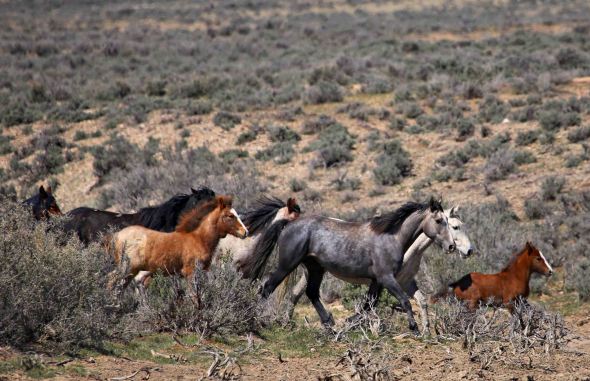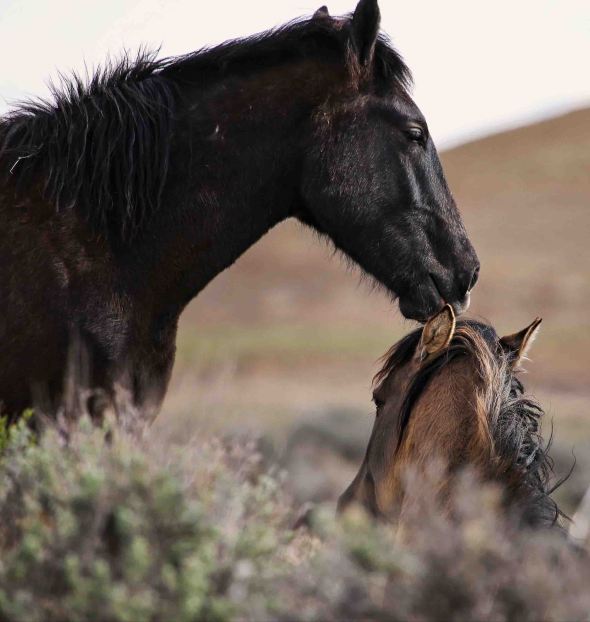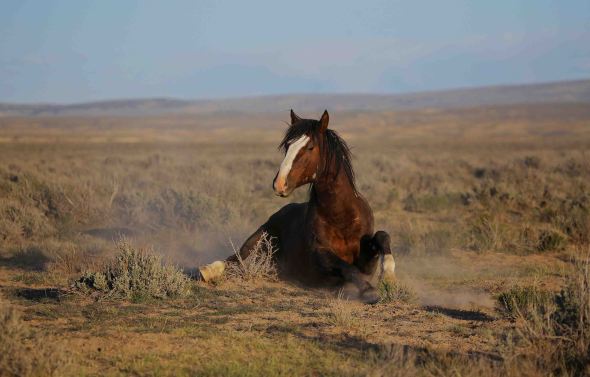Wild Horses Settings f/5.6, 1/2000, ISO 400 FL 360 mm My name is Patrick Brennan, and I'm a wild horse photographer. For the past 5 years I've been traveling from my home in Denver, Colorado to the western most portion of our state to photograph the wild Mustang horses of Sand Wash Basin on the high desert plains of NW Colorado. This herd of wild horses lives on 162,000 acres near the Wyoming- Utah border. There are about 590 Mustangs that live on this government protected Horse Management Area. Wild Mustang horses can be found in 10 Western states that have similar protected areas for the wild Mustangs, where nearly 40,000 of them run free and wild. My photo equipment is an important part of what I do out there in the wild, literally in the middle of nowhere; In short, I need to count on it. I have just recently turned to renting my camera bodies and telephoto lenses. My first experience was with LensGiant, and like the wild horses, I'm hooked on this company. I know I'm going to get top tear equipment, delivered to me on time and ready to go to work. The customer service is first rate. LensGiant is now a part of my team that I depend on. On this trip I'm renting the Canon 6D Full Frame Camera Body and the Canon 100-400mm EF f/4.5-5.6L IS USM telephoto lens to add to my other gear. Photographing wild horses is a very unique experience. Not a lot of people do it, in fact, not a lot of people do serious wildlife photography in general. It is very demanding and sometimes dangerous. It is however, very satisfying and rewarding. I and a few other photographers camp out on the high desert range for 5 to 7 days at a time. The nearest town is about 40 miles away with little more than a gas station with a small general store. The roads are few and very rough, and during the late spring and summer months, the Basin is infested with rattlesnakes. Temperatures can soar to 100 plus degrees in July and August. Not a very hospitable environment for photographers to operate in. Being a wild horse photographer is more than just taking pretty pictures of the Mustangs. When I go out on a wild horse shoot I have more than just one objective in mind. Objective one, however, is to find these wild beauties in the 162,000 acres of rolling hills, deep ravines, providing many places for the bands to hide. Having photographed this herd for five years, I know their patterns and sometimes their favorite grazing and waterholes, which is a big help. Binoculars ready on the dashboard, we start driving the roads and trails looking for the wild Mustangs. After driving for a bit we spot an area with color like dots on the horizon that could be a band of horses. A look through the binoculars confirms we have our first sighting of horses. Problem is they are about 2 and a half miles from the road, which means a long hike will be required.  Settings: f/5.6, 1/2000, ISO 400 FL 400 mm After getting our cameras and large telephoto lenses securely strapped to us, we start out the hike over the range covered by sage brush, rocks and dirt. We finally get to about two football fields from the horses we spotted from the road and just simply stop to see what the herd will do. Each stallion has their own degree of security comfort when it comes to distance. Time to ready the cameras and lenses for action. The largest lens I carry out with me is the Canon 100-400mm. I don't go larger so I don't have to mess with a tripod. I want to be ready when the action starts, not fooling with equipment. After waiting about ten minutes to make sure the horses won't spook, we approach in a slanting line about 5 yards at a time. As soon as any of the horses take notice of our movement-we stop and wait some more. Our goal is to get within 100 yards before beginning to taking pictures. By this time we have identified the family band or band of bachelor stallions. In a family band, especially in the spring foaling season, you look for any new baby foals.  Settings f/5.6, 1/1600, ISO 320 and FL 400 mm Settings f/5.6, 1/1600, ISO 320 and FL 400 mmTo my left I spot this little white and brown patch among the sage brush enjoying the morning sun with mom grazing not far away. I didn't want to get any further in and disturb the scene before me, so I begin snapping away at my present distance. I can tell I'm going to need all of my 400mm lens to get a good picture of this little foal. My settings were f/5.6 1/1600 sec and ISO 250. One of the practical objectives of taking pictures of new foals is for documentation purpose in the ever changing size of the herd. I and many of the photographers that shoot out here belong to a group called the Sand Wash Basin Advocate Team, and we work with the government agency charged with protection of the wild Mustangs by providing data and information on the horses that we come across. Later in the day we spot a group of Bachelor stallions interacting with one of the established band stallions and that usually means a wild horse fight. We were in a pretty good position when the fighting began. Within seconds a loud screeching sound comes from one of the stallions and the fight is on. These battles can last a few seconds or go on for several minutes until one of the stallions yields and turns and runs away. These young Mustangs are just learning the finer points of battle by taking on one of the older stallions.  Settings f/5.6, 1/1600 ISO 320 and a focal length of 300mm Settings f/5.6, 1/1600 ISO 320 and a focal length of 300mmThe stallion fight was a fitting end to the first day of our camping adventure with the wild Mustangs of Sand Wash Basin. Over the next few days we were able to encounter many of the wild horses that occupied these 162,000 acres in NW Colorado. We found some at the numerous waterholes where the horses come to drink, bathe and play. An average adult wild Mustang requires 20 to 30 gallons of water per day. Once you find out the waterholes the horses favor and what time they like to visit, than it's easy to get there ahead of time and set up behind some cover and wait for them to come to you. That sure cuts down on the hiking to get to them. Before long we see our first band of mustangs come running down a trail to the waterhole. To our surprise we see a new little foal at the head of the pack.  Settings: f/5.6, 1/2000 ISO 320 at 400mm Settings: f/5.6, 1/2000 ISO 320 at 400mm Settings: f/5.6, 1/2000 ISO 320 at 400mm As the day begins to wind down and the sun sits lower in the sky on the wild Mustangs of Sand Wash Basin, so do the horses. Here a couple of young bachelor stallions rest up after getting water.  Settings: f/5.6, 1/1600, ISO 800, at 400mm Settings: f/5.6, 1/1600, ISO 800, at 400mmAnd one mare here decided to take a roll in the dirt to relax and get off any bugs that might be hitching a ride. It sure looks like she really enjoyed her role in the dirt.  Settings: f/5, 1/1250, ISO 500, FL 180 mm Settings: f/5, 1/1250, ISO 500, FL 180 mm f/5, 1/1250, ISO 320, FL 180 mm f/5, 1/1250, ISO 320, FL 180 mmOne of the greatest joys a wild horse photographer can have is to be the first one to discover and photograph a band new foal. That happened for me on the last trip. I was photographing one of the larger family bands belonging to Lead Band stallion- Willie Nelson (Named for the singer of course). Willies band is one of the largest in the herd with 21 horses. He has 4 mares, numerous satellite, or lieutenant stallions and bunch of young ones. I was panning the herd with my Canon 100-400 lens and noticed a little brown blob not far from one of the mares. I thought just possible this little one was born in the last several days. I focused in tighter and got a good look at the brown foal.  Settings: f/5.6, 1/1600, ISO 400, FL 400 mm Settings: f/5.6, 1/1600, ISO 400, FL 400 mmThen I got a bonus shot. The foal decides it's time for some mid-morning mother's milk.  Settings: f/5.6, 1/1600, ISO 320, at 400mm Settings: f/5.6, 1/1600, ISO 320, at 400mmOnce I got back to civilization and consulted with others in our Sand Wash Basin Advocate group, it was confirmed that I was the first to find this little foal colt. That meant I got to name him. I named him Shotgun in honor of Willie Nelson's 1973 mega hit album- Shotgun Willie To see more wild Mustang images and other photography work-go to my website: www.blackhatphoto.us |